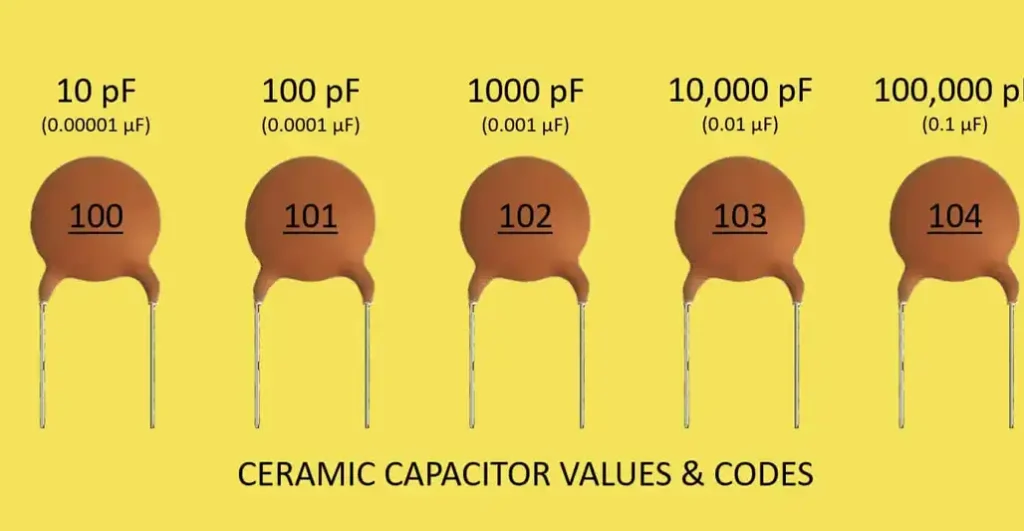Have you used the ceramic capacitors? Here is the ultimate guide telling you how to read a ceramic capacitor.
Understanding Ceramic Capacitors
Ceramic capacitors are ubiquitous components in the world of electronics. These tiny workhorses, often just millimeters in size, play a crucial role in circuits by storing electrical energy. But beneath their unassuming exterior lies a hidden language – a code that reveals their capacitance, a key characteristic.
Reading Ceramic Capacitor Values

Reading ceramic capacitor values is all about understanding a simple code system. Here’s a breakdown:
The Code: Most ceramic capacitors have a three-digit code printed on their surface. This code represents the capacitance value of the capacitor in picofarads (pF). Sometimes, a fourth character (a letter) might be present, indicating the tolerance.
Decoding the Three Digits:
First Two Digits: These are the significant digits that represent the base value of the capacitance.
Third Digit: This digit acts as a multiplier, expressed as a power of 10. Here’s the key:
- 0: Multiplier of 1 (10^0 = 1)
- 1: Multiplier of 10 (10^1 = 10)
- 2: Multiplier of 100 (10^2 = 100)
- 3: Multiplier of 1,000 (10^3 = 1,000)
- …and so on
Example:
Imagine a capacitor with the code “223”. Here’s how to decipher it:
- Significant digits (22): Base value
- Multiplier (3): 1,000
Therefore, the capacitance value is:
22 x 1,000 pF = 22,000 pF
Units: Most ceramic capacitors use picofarads (pF) for capacitance, but some might use nanofarads (nF) for larger values. If the value is large and doesn’t seem to make sense in pF, check if it’s labeled as nF.
Optional Fourth Character: Tolerance
The fourth character, if present, indicates the tolerance of the capacitor. This represents the allowed deviation of the actual capacitance from the marked value. Here are some common tolerance codes:
- M = ±20%
- K = ±10%
- J = ±5%
- G = ±2%
Example:
If the code is “472K”, the capacitance is:
- 47 x 100 pF (4,700 pF) with a tolerance of ±10%.
Important Tips:
- Color Coding is Unreliable: Avoid using color coding for ceramic capacitors. This method is not standardized and can vary by manufacturer. Rely solely on the three-digit (or four-digit) code.
- Datasheets for the Win: If you have the capacitor’s datasheet or manufacturer information, it will provide the most precise details about its capacitance, tolerance, and other specifications.
By understanding this code system, you can easily read the value and tolerance of most ceramic capacitors, enabling you to select the right component for your electronic projects!
How to Read a Ceramic Capacitor
Here’s a guide on how to read a ceramic capacitor:
Understanding the Code: Most ceramic capacitors display their capacitance value using a three-digit code printed on their small body. This code is a combination of numbers and sometimes a letter, representing the capacitance and tolerance.
Decoding the Code:
- The First Two Digits: These are the significant digits, indicating the base value of the capacitance.
- The Third Digit: This digit acts as a multiplier, expressed as a power of 10.
- A “0” in the third digit signifies a multiplier of 1 (10^0 = 1).
- A “3” in the third digit signifies a multiplier of 1,000 (10^3 = 1,000).
Putting it Together:
Let’s say a ceramic capacitor has the code “473” printed on it. Here’s how to decipher it:
- Significant digits (47): This is the base value.
- Multiplier (3): This is the multiplier (1,000).
Therefore, the capacitance value of this capacitor is 47 x 1,000 picofarads (pF), which equals 47,000 pF.
Capacitance Units: The capacitance of ceramic capacitors is typically measured in picofarads (pF). However, some capacitors might use nanofarads (nF) for larger capacitance values.
Tolerance Code (Optional):
Sometimes, a fourth letter might be included in the code after the three digits. This letter represents the tolerance of the capacitor, indicating how much the actual capacitance can deviate from the marked value. Here are some common tolerance codes:
- M = ±20%
- K = ±10%
- J = ±5%
- G = ±2%
Example: If the code is “222K”, the capacitance is 22 x 100 pF (2,200 pF) with a tolerance of ±10%.
Additional Tips:
- Color Coding is Unreliable: While some information online might suggest color coding for ceramic capacitors, this method is not recommended. The color coding system can vary by manufacturer and lacks standardization. Stick to the three-digit (or four-digit) code for accuracy.
- Datasheets are Your Best Resource: If you have the capacitor’s datasheet or manufacturer information, it will provide the most accurate details about its capacitance value, tolerance, and other specifications.
By following these steps, you can effectively decode the value and other relevant information from the coding system on most ceramic capacitors. This knowledge empowers you to select the right capacitor for your electronic projects!




















